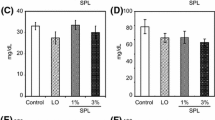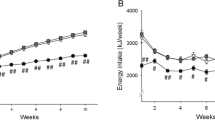Abstract
Plasma and liver lipids were studied in male weanling rats fed diets containing moderate levels of fat (6% by weight) as sunflower oil (SF diet, rich in linoleic acid), salmon oil (SM diet, rich in long-chain n-3 fatty acids), or a blend of peanut and rapeseed oil (PR diet, rich in oleic acid). After nine weeks of feeding, the fasting plasma cholesterol concentrations were 49 and 24% lower in groups SM and SF, respectively, as compared to group PR. Both dietary salmon oil and sunflower oil lowered the tricylglycerol concentration of plasma and liver but, unexpectedly, the response was higher with sunflower oil. Indeed, in group SM the values were 15 and 30% lower in plasma and liver, whereas in group SF, they were 24 and 53% lower, respectively. As compared to group PR, liver triacylglycerols and microsomes contained 2.5- and 2.3-fold less oleic acid, respectively, in group SF, and they were 9.2- and 3.2-fold enriched in n-3 fatty acids, respectively, in group SM. The liver triacylglycerol concentrations were correlated with changes in the microsomal Mg2+-dependent phosphatidate phosphohydrolase activity (r=0.47,P<0.01). As oleic acid, unlike long-chain n-3 fatty acids, is considered to promote the triacylglycerol synthesis and secretion, our findings suggest that changes in the membrane fatty acid composition could affect the triacylglycerol content of liver and plasma. Moreover, the availability within the liver, of oleic acid, predominantly incorporated into triacylglycerols, might limit the triacylglycerol production in SF-fed rats.
Similar content being viewed by others
Abbreviations
- DMPC:
-
dimyristoylphosphatidylcholine
- HDL:
-
high density lipoprotein
- LDL:
-
low density lipoprotein
- PA:
-
Lα-phosphatidate
- PAP:
-
phosphatidate phosphohydrolase
- PR:
-
a blend of peanut oil and rapeseed oil
- PUFA:
-
polyunsaturated fatty acids
- SF:
-
sunflower oil
- SM:
-
salmon oil
- VLDL:
-
very low density lipoprotein
References
Frémont, L., Gozzelino, M.T., and Hojjat, T. (1995) Effects of Moderate Fat Intake with Different n-3 Fatty Acid Sources and n-6/n-3 Ratios on Serum and Structural Lipids in Rats,Reprod. Nutr. Dev. 35, 503–515.
Harris, W.S., Connor, W.E., and McMurry, M.P. (1983) The Comparative Reductions of the Plasma Lipids and Lipoproteins by Dietary Polyunsaturated Fats: Salmon Oil Versus Vegetable Oils,Metabolism 32, 179–184.
Balasubramaniam, S., Simons, L.A., Chang, S., and Hickie, J.B. (1985) Reduction in Plasma Cholesterol and Increase in Biliary Cholesterol by a Diet Rich in n-3 Fatty Acids in the Rat,J. Lipid Res. 26, 684–689.
Huang, Y.S., Nassar, B.A., and Horrobin, D.F. (1986) Changes of Plasma Lipids and Long-Chain n-3 and n-6 Fatty Acids in Plasma, Liver, Heart and Kidney Phospholipids of Rats Fed Variable Levels of Fish Oil with or without Cholesterol Supple-mentation,Biochim. Biophys. Acta 879, 22–27.
Roach, P.D., Kambouris, A.M., Trimble, R.P., Topping, D.L., and Nestel, P.J. (1987) The Effects of Dietary Fish Oil on Hepatic High Density and Low Density Lipoprotein Receptor Activities in the Rat,FEBS Letters 222, 159–162.
Chautan, M., Chanussot, F., Portugal, H., Pauli, A.M., and Lafont, H. (1990) Effects of Salmon Oil and Corn Oil on Plasma Lipid Level and Hepato-Biliary Cholesterol Metabolism in Rats,Biochim. Biophys. Acta 1046, 40–45.
Ribeiro, A., Mangeney, M., Cardot, P., Loriette, C., Rayssiguier, Y., Chambaz, J., and Bereziat, G. (1991) Effect of Dietary Fish Oil and Corn Oil on Lipid Metabolism and Apolipoprotein Gene Expression by Rat Liver,Eur. J. Biochem. 196, 499–507.
Otto, D.A., Tsai, C.E., Baltzell, J.K., and Wooten, J.T. (1991) Apparent Inhibition of Hepatic Triacylglycerol Secretion, Independent of Synthesis, in High-Fat Fish Oil-Fed Rats: Role for Insulin,Biochim. Biophys. Acta 1082, 37–48.
Wong, S.H., Nestel, P.J., Trimble, R.P., Storer, G.B., Illman, R.J., and Topping, D.L. (1984) The Adaptative Effects of Dietary Fish and Safflower Oil on Lipid and Lipoprotein Metabolism in Perfused Rat Liver, Biochim.Biophys. Acta 792, 103–109.
Berge, R.K., Nilsson, A., and Husoy, A.M. (1988) Rapid Stimulation of Liver Palmitoyl-CoA Synthetase, Carnitine Palmitoyl-transferase and Glycerophosphate Acyltransferase Compared to Peroxisomal β-Oxidation and Palmitoyl-CoA Hydrolase in Rats Fed High-Fat Diets,Biochim. Biophys. Acta 960, 417–426.
Willumsen, N., Skorve, J., Hexeberg, S., Rustan, A.C., and Berge, R.K. (1993) The Hypotriglyceridemic Effect of Eicosapentaenoic Acid in Rats Is Reflected in Increased Mitochondrial Fatty Acid Oxidation Followed by Diminished Lipogenesis,Lipids 28, 683–690.
Strum-Odin, R., Adkins-Finke, B., Blake, W.L., Phinney, S.D., and Clarke, S.D. (1987) Modification of Fatty Acid Composition of Membrane Phospholipid in Hepatocyte Monolayer with n-3, n-6 and n-9 Fatty Acids and Its Relationship to Triacylglycerol Production,Biochim. Biophys. Acta 921, 378–391.
Rustan, A.C., Nossen, J.Ø., Christiansen, E.N., and Drevon, C.A. (1988) Eicosapentaenoic Acid Reduces Hepatic Synthesis and Secretion of Triacylglycerol by Decreasing the Activity of Acyl-Coenzyme A:1,2-Diacylglycerol Acyltransferase,J. Lipid Res. 29, 1417–1426.
Murthy, S., Albright, E., Mathur, S.N., and Field, F.J. (1990) Effect of Eicosapentaenoic Acid on Triacylglycerol Transport in CaCo-2 Cells,Biochim. Biophys. Acta 1045, 147–155.
Marsh, J.B., Topping, D.L., and Nestel, P.J. (1987) Comparative Effects of Dietary Fish Oil and Carbohydrate on Plasma Lipids and Hepatic Activities of Phosphatidate Phosphohydrolase, Diacylglycerol Acyltransferase and Neutral Lipase Activities in the Rat,Biochim. Biophys. Acta 922, 239–243.
Wong, S.H., and Marsh, J.B. (1988) Inhibition of Apolipoprotein Secretion and Phosphatidate Phosphohydrolase Activity by Eicosapentaenoic and Docosahexaenoic Acids in the Perfused Rat Liver,Metabolism 37, 1177–1181.
Halminski, M.A., Marsh, J.B., and Harrison, E.H. (1991) Differential Effects of Fish Oil, Safflower Oil and Palm Oil on Fatty Acid Oxidation and Glycerolipid Synthesis in Rat Liver,J. Nutr. 121, 1554–1561.
Al-Shurbaji, A., Larsson-Backström, C., Berglund, L., Eggertsen, G., and Björkhem, I. (1991) Effect of n-3 Fatty Acids on the Key Enzymes Involved in Cholesterol and Triglyceride Turnover in Rat Liver,Lipids 26, 385–389.
Surette, M.E., Whelan, J., Broughton, K.S., and Kinsella, J.E. (1992) Evidence for Mechanisms of the Hypotripotriglyceridemic Effect of n-3 Polyunsaturated Fatty Acids,Biochim. Biophys. Acta 1126, 199–205.
Davis, R.A., and Boogaerts, J.R. (1982) Intrahepatic Assembly of Very Low Density Lipoproteins,J. Biol. Chem. 257, 10908–10913.
Nossen, J.Ø., Rustan, A.C., Gloppestad, S.H., Mälbakken, S., and Drevon, C.A. (1986) Eicosapentaenoic Acid Inhibits Synthesis and Secretion of Triacylglycerols by Cultured Rat Hepatocytes,Biochim. Biophys Acta 879, 56–65.
Benner, K.G., Sasaki, A., Gowen, D.R., Weaver, A., and Connor, W.E. (1990) The Differential Effect of Eicosapentaenoic Acid and Oleic Acid on Lipid Synthesis and VLDL Secretion in Rabbit Hepatocytes,Lipids 25, 534–540.
Brindley, D.N. (1984) Intracellular Translocation of Phosphatidate Phosphohydrolase and Its Possible Role in the Control of Glycerolipid Synthesis,Prog. Lipid Res. 23, 115–133.
Cascales, C., Mangiapane, H., and Brindley, D.N. (1984) Oleic Acid Promotes the Activation and Translocation of Phosphatidate Phosphohydrolase from the Cytosol to Particulate Fractions of Isolated Rat Hepatocytes,Biochem. J. 219, 911–916.
Bradford, M.M. (1976) A Rapid and Sensitive Method for the Quantitation of Microgram Quantities of Protein Utilizing the Principle of Protein-Dye Binding,Anal. Biochem. 72, 248–254.
Folch, J., Lees, M., and Sloane-Stanley, G.H. (1957) A Simple Method for the Isolation and Purification of Total Lipides from Animal Tissues,J. Biol. Chem. 226, 497–509.
Bartlett, G.R. (1959) Phosphorus Assay in Column Chromatography.J. Biol. Chem. 234, 466–468.
Warnick, C.R., Cheung, M.C., and Albers, J.J. (1979) Comparison of Current Methods for High-Density Lipoprotein Cholesterol Quantitation,Clin. Chem. 25, 596–604.
Sjöblom, L., and Eklund, A. (1983) Determination of HDL2 Cholesterol by Precipitation with Dextran Sulfate and Magnesium Chloride: Establishing Optimal Conditions for Rat Plasma,Lipids 24, 532–534.
Walton, P.A., and Possmayer, F. (1985) Mg2+-Dependent Phosphatidate Phosphohydrolase of Rat Lung: Development of an Assay Employing a Defined Chemical Substrate Which Reflects the Phosphohydrolase Activity Measured Using Membrane-Bound Substrate,Anal. Biochem. 151, 479–486.
Mavis, R.D., Finkelstein, J.N., and Hall, B.P. (1978) Pulmonary Surfactant Synthesis. A Highly Active Microsomal Phosphatidate Phosphohydrolase in the Lung.J. Lipid Res. 19, 467–477.
Berglund, L., Björkhem, I, and Einarsson, K. (1982) Apparent Phosphorylation-Dephosphorylation of Soluble Phosphatidic Acid Phosphatase in Rat Liver,Biochem. Biophys. Res. Comm. 105, 288–295.
Juanida, P., and Rocquelin, G. (1985) Rapid and Convenient Separation of Phospholipids and Non-Phosphorus Lipids from Rat Heart Using Silica Cartridges,Lipids 20, 40–41.
Galli, C., Agradi, E., and Paoletti, R. (1974) The (n-6) Pentaene: (n-3) Hexaene Fatty Acid Ratio as an Index of Linolenic Acid Deficiency,Biochim. Biophys. Acta 369, 142–145.
Rustan, A.C., Christiansen, E.N., and Drevon, C.A. (1992) Serum Lipids, Hepatic Glycerolipid Metabolism and Peroxisomal Fatty Acid Oxidation in Rats Fed ω-3 and ω-6 Fatty Acids,Biochem. J. 283, 333–339.
Sturton, R.G., and Brindley, D.N. (1978) Problems Encountered in Measuring the Activity of Phosphatidate Phosphohydrolase,Biochem. J. 171, 263–266.
Jamal, Z., Martin, A., Gomez-Munoz, A., and Brindley, D.N. (1991) Plasma Membrane Fractions from Rat Liver Countain a Phosphatidate Phosphohydrolase Distinct from That in the Endoplasmic Reticulum and Cytosol,J. Biol. Chem. 266, 2988–2996.
Periago, J.L., Pita, M.L., Sanchez del Castillo, M.A., Calamaño G., and Suarez, M.D. (1989) Changes in Lipid Composition of Liver Microsomes and Fatty Acyl-CoA Desaturases Activities Induced by Medium-Chain Triglyceride Feeding,Lipids 24, 383–388.
Gibson, R.A., McMurchie, E.J., Charnock, J.S., and Kneebone, G.M. (1984) Homeostatic Control of Membrane Fatty Acid Composition in the Rat After Dietary Lipid Treatment,Lipids 19, 942–951.
Clarke, S.D., Romsos, D.R., and Leveille, G.A. (1976) Specific Inhibition of Hepatic Fatty Acid Synthesis Exerted by Dietary Linoleate and Linolenate in Essential Fatty Acid Adequate Rats,Lipids 11, 485–490.
Yang, Y.T., and Williams, M.A. (1978) Comparison of C18-,C20- and C22-Unsaturated Fatty Acids in Reducing Fatty Acid Synthesis in Isolated Rat Hepatocytes,Biochim. Biophys. Acta 531, 133–140.
Otto, D.A., Baltzell, J.K., and Wooten, J.T. (1992) Reduction in Triacylglycerol Levels by Fish Oil Correlates with Free Fatty Acid Levels inad libitum Fed Rats,Lipids 27, 1013–1017.
Yeo, Y.K., and Holub, B.J. (1990) Influence of Dietary Fish Oil on the Relative Synthesis of Triacylglycerol and Phospholipids in Rat Liverin vivo, Lipids 25, 811–814.
Whelan, J., Surette, M.E., Li-Stiles, B., and Bailey, J.W. (1995) Evidence That Dietary Arachidonic Acid Increases Circulating Triglycerides,Lipids 30, 425–429.
Iritani, N., and Narita, R. (1984) Changes of Arachidonic Acid and n-3 Polyunsaturated Fatty Acids of Phospholipid Classes in Liver, Plasma and Platelets During Dietary Fat Manipulation,Biochim. Biophys. Acta 793, 441–447.
Author information
Authors and Affiliations
About this article
Cite this article
Frémont, L., Gozzelino, MT. Dietary sunflower oil reduces plasma and liver triacylglycerols in fasting rats and is associated with decreased liver microsomal phosphatidate phosphohydrolase activity. Lipids 31, 871–878 (1996). https://doi.org/10.1007/BF02522983
Received:
Revised:
Accepted:
Issue Date:
DOI: https://doi.org/10.1007/BF02522983




